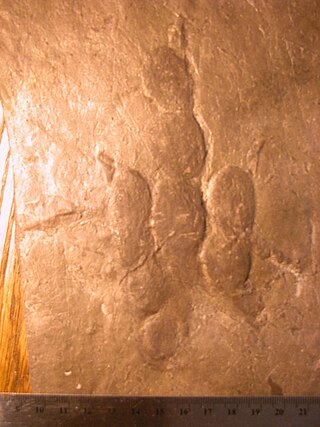
Grallator ["GRA-luh-tor"] is an ichnogenus which covers a common type of small, three-toed print made by a variety of bipedal theropod dinosaurs. Grallator-type footprints have been found in formations dating from the Early Triassic through to the early Cretaceous periods. They are found in the United States, Canada, Europe, Australia, Brazil and China, but are most abundant on the east coast of North America, especially the Triassic and Early Jurassic formations of the northern part of the Newark Supergroup. The name Grallator translates into "stilt walker", although the actual length and form of the trackmaking legs varied by species, usually unidentified. The related term "Grallae" is an ancient name for the presumed group of long-legged wading birds, such as storks and herons. These footprints were given this name by their discoverer, Edward Hitchcock, in 1858.

Nanshiungosaurus is a genus of therizinosaurid that lived in what is now Asia during the Late Cretaceous of South China. The type species, Nanshiungosaurus brevispinus, was first discovered in 1974 and described in 1979 by Dong Zhiming. It is represented by a single specimen preserving most of the cervical and dorsal vertebrae with the pelvis. A supposed and unlikely second species, "Nanshiungosaurus" bohlini, was found in 1992 and described in 1997. It is also represented by vertebrae but this species however, differs in geological age and lacks authentic characteristics compared to the type, making its affinity to the genus unsupported.
The Ziliujing Formation is a geological formation in China, It is Early Jurassic in age. It is part of the stratigraphy of the Sichuan Basin. The dinosaur Gongxianosaurus and indeterminate theropod material are known from the Dongyuemiao Member of the formation, as well as dinosaur footprints, Zizhongosaurus and indeterminate prosauropods from the Da'anzhai Member. The basal sauropod Sanpasaurus is known from the Maanshan Member. An unnamed stegosaur and the pliosauroid plesiosaur Sinopliosaurus are also known from this formation but they were found an indeterminate member. An unnamed teleosaurid known from a complete skull has also been found in the formation, pending a formal description. The deposition environment during the Da'anzhai Member in the lower Toarcian is thought to have been that of a giant freshwater lake encompassing the whole of the Sichuan basin, around 3 times larger than Lake Superior, coeval with the Toarcian Oceanic Anoxic Event around 183 Ma.

Eubrontes is the name of fossilised dinosaur footprints dating from the Late Triassic and Early Jurassic. They have been identified from France, Poland, Slovakia, Czech Republic, Italy, Spain, Sweden, Australia (Queensland), US, India, China and Brazil (South).
The Tuchengzi Formation is a geological formation in China whose strata span the Tithonian to Berriasian ages. Dinosaur fossils, particularly footprints, have been found from the formation.
The Haman Formation is an Early Cretaceous geological formation in South Korea. It has been dated to the Albian, with an estimated maximum depositional age of 105.4 ± 0.4 Ma. The deposit is known for its tracks, including those of dinosaurs, pterosaurs and birds. It overlies the Silla Conglomerate which overlies the Chilgok Formation. It is laterally equivalent to the Sagog Formation.
The Nanxiong Formation is a Late Cretaceous geologic formation in Guangdong Province. Dinosaur remains are among the fossils that have been recovered from the formation.

The Majiacun Formation is a Santonian to Coniacian geologic formation in China. Dinosaur remains are among the fossils that have been recovered from the formation.
Tonganosaurus is a genus of mamenchisaurid sauropod dinosaur, similar to Omeisaurus. It is known from one specimen consisting of twenty vertebrae, a front limb and pectoral girdle, and a complete hind limb with partial hip. It was discovered in the Yimen Formation, China. The horizon of the specimen and the age of the Yimen Formation is controversial. The formation has been divided into three levels, and Tonganosaurus appears to be of late Early Jurassic (Pliensbachian) age. Tonganosaurus is the oldest known member of the mamenchisaurids, being almost 15 million years older than the next-oldest members of the group. It was first named by Li Kui, Yang Chun-Yan, Liu Jian and Wang Zheng-Xin in 2010 and the type species is Tonganosaurus hei.
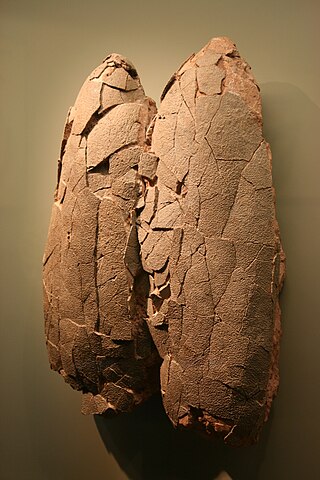
Macroelongatoolithus is an oogenus of large theropod dinosaur eggs, representing the eggs of giant caenagnathid oviraptorosaurs. They are known from Asia and from North America. Historically, several oospecies have been assigned to Macroelongatoolithus, however they are all now considered to be a single oospecies: M. carlylensis.
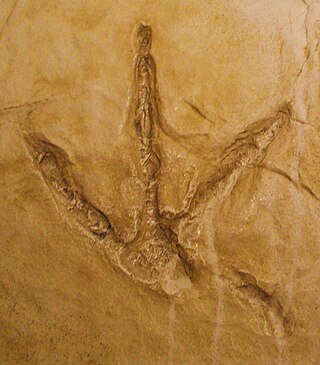
Saurexallopus is an ichnogenus of four-toed theropod footprints from the Late Cretaceous period. The type ichnospecies is S. lovei, named and described in 1996 from the Harebell Formation. The taxon was originally named Exallopus, but later renamed as Saurexallopus as the former was preoccupied by a polychaete. A second species, S.zerbsti, was named and described in 2004 from the Lance Formation. In 2012 a four-toed track from the Cantwell Formation was referred to Saurexallopus indet. It was also suggested that Saurexallopus was produced by a therizinosaur taxon. In 2013 based on skeletal proportions it was suggested that the ichnotaxon was instead produced by an oviraptorosaur taxon. In 2014 a third species was named, S.cordata, from the Wapiti Formation. In 2018 several tracks from the Blackhawk Formation were referred to Saurexallopus indet.

Tyrannosauripus is an ichnogenus of dinosaur footprint. It was discovered by geologist Charles "Chuck" Pillmore in 1983 and formally described by Martin Lockley and Adrian Hunt in 1994. This fossil footprint from northern New Mexico is 96 cm long and given its Late Cretaceous age, it very likely belonged to the giant theropod dinosaur Tyrannosaurus rex. In 2016 the size of this individual was estimated at 11.4 meters and 5.8-6.9 tonnes. Similar tridactyl dinosaur tracks in North America were discovered earlier and named Tyrannosauropus in 1971, but they were later recognized as hadrosaurid tracks and their description deemed inadequate, with Tyrannosauropus regarded as a nomen dubium. True footprints likely from Tyrannosaurus would not be found until the discovery of Tyrannosauripus. In 2007, a large tyrannosaurid track was found also in eastern Montana. In 2016, a probable fossil trackway of Tyrannosaurus was discovered in Wyoming.

Qianzhousaurus is a genus of tyrannosaurid dinosaur that lived in Asia during the Maastrichtian age of the Late Cretaceous period. There is currently only one species named, the type species Qianzhousaurus sinensis, which is a member of the tribe Alioramini and most closely related to Alioramus, the only other known alioramin.
The Jingchuan Formation is a Barremian geologic formation in China. Various dinosaur fossils and tracks have been reported from the formation.
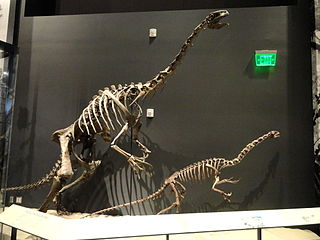
The timeline of therizinosaur research is a chronological listing of events in the history of paleontology focused on therizinosaurs. They were unusually long-necked, pot-bellied, and large-clawed herbivorous theropods most closely related to birds. The early history of therizinosaur research occurred in three phases. The first phase was the discovery of scanty and puzzling fossils in Asia by the Central Asiatic Expeditions of the 1920s and Soviet-backed research in the 1950s. This phase resulted in the discovery of the Therizinosaurus cheloniformis type specimen. Soviet paleontologist Evgeny Maleev interpreted these unusual remains as belonging to some kind of gigantic turtle.
This article records new taxa of trace fossils of every kind that are scheduled to be described during the year 2019, as well as other significant discoveries and events related to trace fossil paleontology that are scheduled to occur in the year 2019.
The Xintiangou Formation is a geological formation in China. Part of the stratigraphy of the Sichuan Basin, it is of an uncertain Middle Jurassic age, with preliminary U-Pb estimates giving an age range of 170 ma. It predominantly consists of interbedded mudstone and sandstone, with subordinate shelly limestone. At the Laojun site remains of lungfish, bony fish, freshwater sharks, temnospondyls, plesiosaurs, crocodyliformes, the Xinjiangchelyid turtle Protoxinjiangchelys and tritylodontids are known. The dinosaurs Sanxiasaurus,Yunyangosaurus, and indeterminate sauropods are also known from the formation. Theropod and ornithopod tracks have also been reported from the formation.
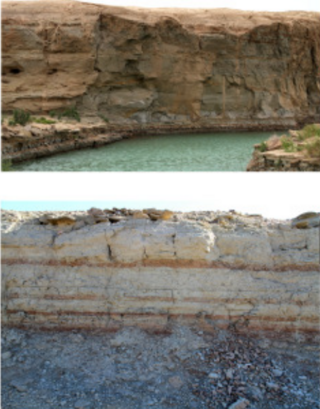
The Shengjinkou Formation is an Early Cretaceous (Aptian)-aged Konservat-Lagerstätte composed of "interbedded red green and yellow variegated mudstones and siltstones" that is part of the larger Tugulu Group of China. Dinosaur and pterosaur remains have been recovered from the formation.
This article records new taxa of every kind of fossil archosaur that were scheduled to be described during 2023, as well as other significant discoveries and events related to the paleontology of archosaurs that were published in 2023.










